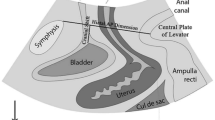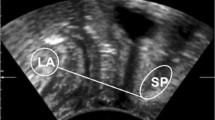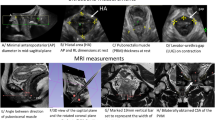Abstract
Introduction and hypothesis
The aim of our study was to assess the performance of levator ani muscle deficiency (LAD) evaluated by 3D endovaginal ultrasound (EVUS) to detect pelvic floor muscle function as assessed by digital examination.
Methods
This cross-sectional study was conducted among 77 patients referred to our urogynecology clinic for pelvic floor dysfunction symptoms. Patients underwent physical examinations including digital pelvic muscle strength assessment using the Modified Oxford scale (MOS). EVUS volumes were evaluated and levator ani muscles were scored according to a validated LAD scoring system. MOS scores were categorized as nonfunctional (scores 0–1) and functional (scores 2–5).
Results
Mean age of participants was 56 (SD ± 12.5) and 71 % were menopausal. Overall, 32.5 % had nonfunctional muscle strength and 44.2 % were classified as having significant LAD. LAD identified by ultrasound had a sensitivity of 60 % (95 % CI 41 –79 %) for detecting nonfunctional muscle and a specificity of 63 % (95 % CI 50 –77 %) for detecting functional muscle. Overall, LAD demonstrated fair ability to discriminate between patients with and those without poor muscle function (area under the ROC curve = 0.70 [95 % CI 0.58–0.83]). Among patients with an LAD score of 16–18, representing almost total muscle avulsion, 70 % had nonfunctional MOS scores, whereas in patients with normal/minimal LAD (scores of 0–4), 89.5 % had functional MOS scores.
Conclusions
Levator ani deficiency and MOS scales were moderately negatively correlated. Among patients with normal morphology or the most severe muscle deficiency, LAD scores can identify the majority of patients with functional or nonfunctional MOS scores respectively.



Similar content being viewed by others
References
Ashton-Miller JA, Delancey JOL (2009) On the biomechanics of vaginal birth and common sequelae. Annu Rev Biomed Eng 11:163–176
Shek KL, Dietz HP (2010) Intrapartum risk factors for levator trauma. BJOG : Int J Obstet Gynaecol 117(12):1485–1492
Kearney R, Miller JM, Ashton-Miller JA, DeLancey JO (2006) Obstetric factors associated with levator ani muscle injury after vaginal birth. Obstet Gynecol 107(1):144–149
Hoyte L, Jakab M, Warfield SK, Shott S, Flesh G, Fielding JR (2004) Levator ani thickness variations in symptomatic and asymptomatic women using magnetic resonance-based 3-dimensional color mapping. Am J Obstet Gynecol 191(3):856–861
Yousuf AA, DeLancey JO, Brandon CJ, Miller JM (2009) Pelvic structure and function at 1 month compared to 7 months by dynamic magnetic resonance after vaginal birth. Am J Obstet Gynecol 201(5):514 e511–514 e517
Weemhoff M, Shek KL, Dietz HP (2010) Effects of age on levator function and morphometry of the levator hiatus in women with pelvic floor disorders. Int Urogynecol J 21(9):1137–1142
Van Delft K, Sultan A, Thakar R, Schwertner-Tiepelmann N, Kluivers K (2014) The relationship between postpartum levator ani muscle avulsion and signs and symptoms of pelvic floor dysfunction. BJOG 121(9):1164–1171
Santoro GA, Wieczorek AP, Dietz HP, Mellgren A, Sultan AH, Shobeiri SA, et al. (2011) State of the art: an integrated approach to pelvic floor ultrasonography. Ultrasound Obstet Gynecol 37(4):381–396
Rostaminia G, White D, Hegde A, Quiroz LH, Davila GW, Shobeiri SA (2013) Levator ani deficiency and pelvic organ prolapse severity. Obstet Gynecol 121(5):1017–1024
Shobeiri SA, Leclaire E, Nihira MA, Quiroz LH, O’Donoghue D (2009) Appearance of the levator ani muscle subdivisions in endovaginal three-dimensional ultrasonography. Obstet Gynecol 114:66–72
Rostaminia G, Manonai J, Leclaire E, Omoumi F, Marchiorlatti M, Quiroz LH, Shobeiri SA (2013) Interrater reliability of assessing levator ani deficiency with 360 degrees 3D endovaginal ultrasound. Int Urogynecol J 25(6):761–766
Rostaminia G, White D, Quiroz L, Shobeiri S (2013) Levator ani role in anal incontinence. Int Urogynecol J 24 [Suppl 1]:S1–S152
Hegde A, Augilar V, Davila G (2013) Levator ani muscle deficiency and stress urinary incontinence. Int Urogynecol J 24 [Suppl 1]:S90 abstract# 112
Rostaminia G, White DE, Quiroz LH, Shobeiri SA (2013) Levator plate descent correlates with levator ani muscle deficiency. Neurourol Urodyn doi: 10.1002/nau.22509
Messelink B, Benson T, Berghmans B, Bo K, Corcos J, Fowler C, Laycock J, Lim PH, van Lunsen R, a Nijeholt GL, Pemberton J, Wang A, Watier A, Van Kerrebroeck P (2005) Standardization of terminology of pelvic floor muscle function and dysfunction: report from the pelvic floor clinical assessment group of the International Continence Society. Neurourol Urodyn 24(4):374–380
Van Delft K, Shobeiri SA, Thakar R, Schwertner-Tiepelmann N, Sultan AH (2013) Intra- and interobserver reliability of levator ani muscle biometry and avulsion using three-dimensional endovaginal sonography. Ultrasound Obstet Gynecol43(2):202–209
Laycock J (1994) Clinical evaluation of the pelvic floor. In: Pelvic floor re-education: principles and practice. Springer, Heidelberg, pp 42–48
DeLancey JO, Morgan DM, Fenner DE, Kearney R, Guire K, Miller JM, Hussain H, Umek W, Hsu Y, Ashton-Miller JA (2007) Comparison of levator ani muscle defects and function in women with and without pelvic organ prolapse. Obstet Gynecol 109(2 Pt 1):295–302
Dietz HP, Shek C (2008) Levator avulsion and grading of pelvic floor muscle strength. Int Urogynecol J Pelvic Floor Dysfunct 19(5):633–636
Steensma AB, Konstantinovic ML, Burger CW, de Ridder D, Timmerman D, Deprest J (2010) Prevalence of major levator abnormalities in symptomatic patients with an underactive pelvic floor contraction. Int Urogynecol J 21(7):861–867
Bo K, Finckenhagen HB (2001) Vaginal palpation of pelvic floor muscle strength: inter-test reproducibility and comparison between palpation and vaginal squeeze pressure. Acta Obstet Gynecol Scand 80(10):883–887
Acknowledgements
This research was supported in part by a grant from the National Institutes of Health, National Institute of General Medical Sciences, grant 1 U54 GM104938-01A1.
Conflicts of interest
None.
Financial disclaimers
None.
Authors’ participation
GR: project development, data collection, manuscript writing; JDP: statistical analysis, manuscript editing; LHQ: project development, manuscript editing; SAS: project development, manuscript editing.
Author information
Authors and Affiliations
Corresponding author
Rights and permissions
About this article
Cite this article
Rostaminia, G., Peck, J.D., Quiroz, L.H. et al. How well can levator ani muscle morphology on 3D pelvic floor ultrasound predict the levator ani muscle function?. Int Urogynecol J 26, 257–262 (2015). https://doi.org/10.1007/s00192-014-2503-x
Received:
Accepted:
Published:
Issue Date:
DOI: https://doi.org/10.1007/s00192-014-2503-x




